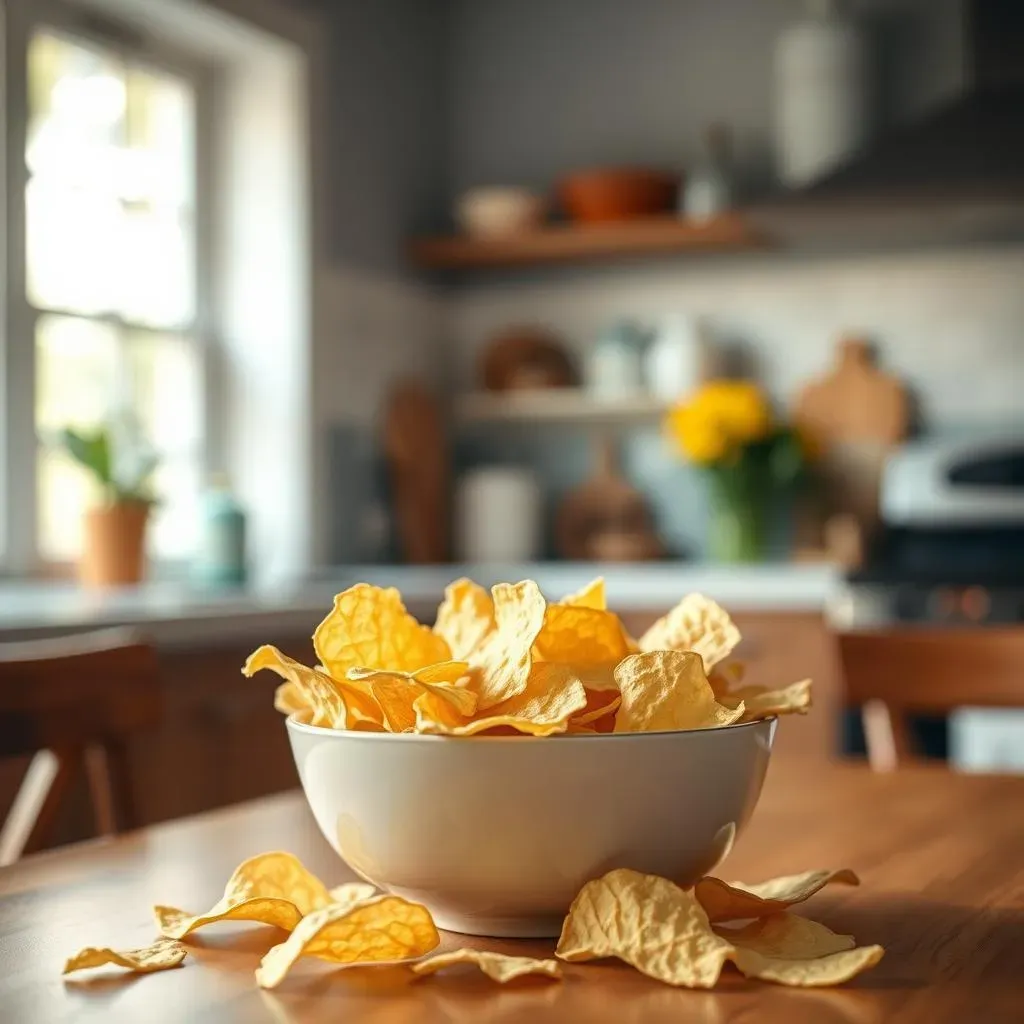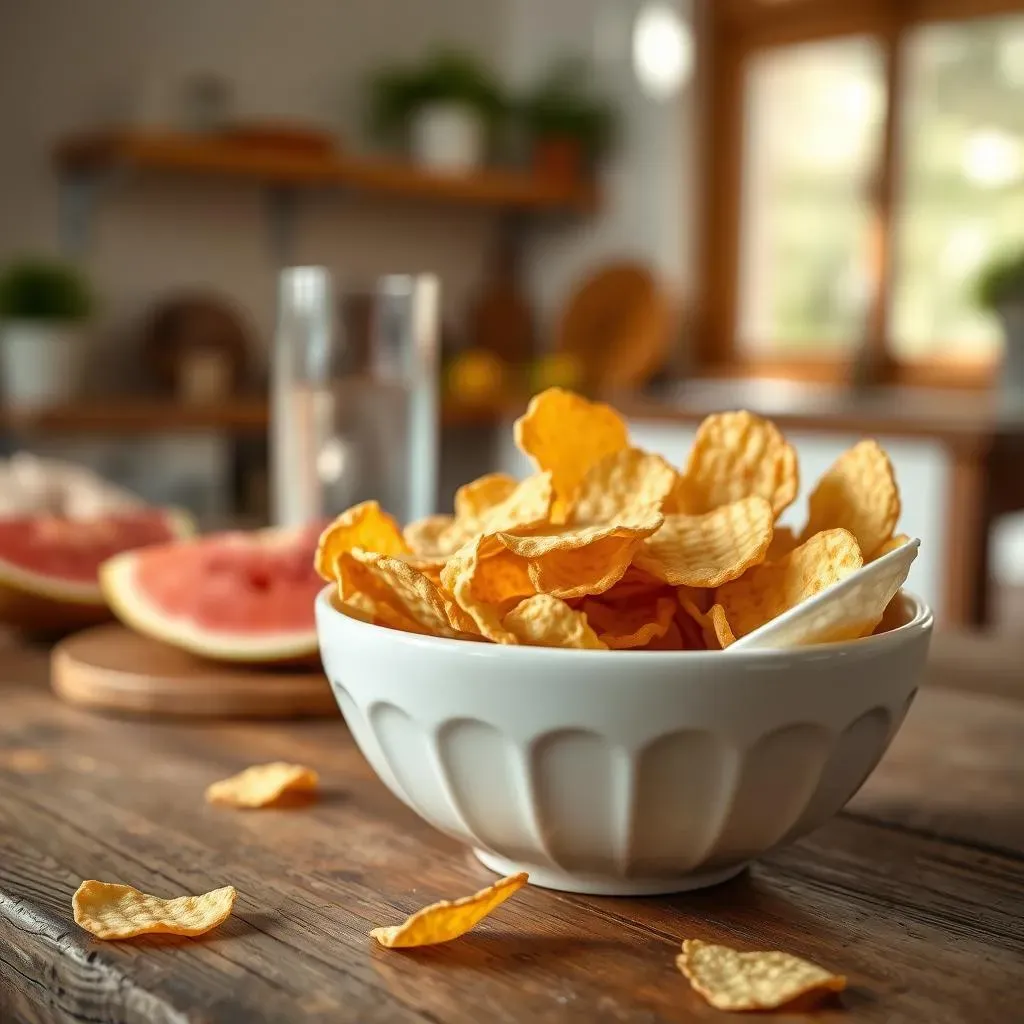Table of Contents
Let's be honest, we all love a good crunchy chip. But when health concerns creep in, those salty snacks can feel like a guilty pleasure. That's where the promise of "fat-free chips" comes in, often presented as a guilt-free indulgence. But are these chips truly the healthy alternative they claim to be? This article will explore the fascinating, and sometimes deceptive, world of fat-free chips. We'll examine the marketing strategies behind these products, uncovering how they appeal to our desire for healthier snacking. Then, we'll dive into the science, looking at the ingredients used to create that satisfying crunch without the fat, including the infamous Olestra. Finally, we'll equip you with knowledge to make informed choices, suggesting delicious and genuinely healthier alternatives to satisfy your cravings. Forget the hype – let's uncover the truth about fat-free chips and discover smarter snacking options. Are you ready to ditch the diet dilemmas and embrace truly satisfying, healthier choices? Let's get started!
The Allure and Illusion of FatFree: Understanding Marketing Tactics

The Allure and Illusion of FatFree: Understanding Marketing Tactics
The Power of "Fat-Free"
The term "fat-free" holds immense power in the food industry. It instantly conjures images of health, lightness, and guilt-free indulgence. Consumers often associate "fat-free" with weight loss and improved well-being, making it a highly attractive label. This association is cleverly exploited by marketers, who use it to boost sales even if the product's overall nutritional profile might not be as stellar as it seems. Think about it – how many times have you grabbed a product simply because it boasted "fat-free" on the packaging?
This marketing tactic relies on a simplification of a complex issue. While reducing fat intake is often beneficial, it's crucial to consider the entire nutritional picture. A product might be fat-free, but it could be loaded with sugar, salt, or other less-than-ideal ingredients. This is why reading the full nutritional label is essential, not just focusing on the "fat-free" claim. For example, some "fat-free" chips might be higher in sodium than their full-fat counterparts, potentially leading to other health concerns. Remember, a balanced diet is key, and focusing solely on one aspect (like fat) can be misleading.
Marketing Strategy | Impact on Consumer |
|---|---|
Highlighting "fat-free" | Perception of health and guilt-free indulgence |
Omission of other ingredients | Uninformed purchasing decisions |
Focus on a single nutrient | Neglect of overall nutritional value |
Hidden Sugars and Other Additives
Often, manufacturers compensate for the removal of fat by adding other ingredients, such as sugar or various additives to enhance flavor and texture. These additions can negate any potential health benefits of a fat-free product. The result? You might be consuming a product that's low in fat but high in sugar, potentially leading to energy crashes, weight gain, and other health issues. This sneaky substitution highlights the importance of closely examining the full ingredient list and nutritional information.
Let's take a look at the example of some fat-free chips. While they might be free of fat, they often contain high levels of refined carbohydrates, which can lead to blood sugar spikes. These spikes are often followed by crashes, leaving you feeling tired and hungry, leading to overeating later on. This cycle can be detrimental to long-term health and weight management. It's a classic case of "one step forward, two steps back" in terms of healthy eating. For healthier alternatives, consider checking out our low-calorie chocolate chips or low-fat chips options.
- Increased sugar content
- Addition of artificial flavors and preservatives
- Higher sodium levels
The Illusion of Health
The "fat-free" label often creates an illusion of health, leading consumers to believe they are making a healthy choice. However, as we've seen, this isn't always the case. Focusing solely on fat content ignores the broader nutritional picture, including sugar, sodium, fiber, and micronutrients. A truly healthy snack should be balanced and provide a range of nutrients, not just be devoid of one specific component.
Many consumers fall for this marketing trick, believing that "fat-free" automatically translates to "healthy." This misconception is perpetuated by advertising and clever packaging design. The reality, however, is far more nuanced. Remember, a truly healthy snack should contribute positively to your overall diet, offering essential nutrients and satisfying your hunger without causing negative health consequences. Don't let the allure of "fat-free" blind you to the importance of reading labels and understanding the full nutritional profile of your food choices. A balanced approach to snacking is always the best strategy.
The Science Behind FatFree Chips: Olestra and Other Alternatives

The Science Behind FatFree Chips: Olestra and Other Alternatives
Olestra: The Controversial Fat Substitute
Let's talk about Olestra, the infamous fat substitute that once dominated the fat-free chip scene. It's a chemically modified fat that the body can't digest, meaning it passes right through, preventing fat absorption. Sounds amazing, right? Well, not quite. While Olestra successfully removed fat from chips, it also caused some pretty unpleasant side effects for many consumers – gastrointestinal distress, to put it mildly. This led to a massive number of complaints and even lawsuits, ultimately impacting the popularity of Olestra-based products.
The science behind Olestra is complex, but the gist is this: It's a large molecule that the body's enzymes can't break down. This means it doesn't provide any calories or nutritional value, but it also has a tendency to whisk away fat-soluble vitamins from your system. Although it allowed for truly fat-free chips, the side effects proved too much for most consumers to tolerate. The FDA even required warning labels on Olestra-containing products, highlighting potential digestive upset. This is a cautionary tale about the potential downsides of aggressively pursuing fat reduction without considering the overall health implications. For a healthier, less disruptive snack, you might want to check out our selection of low-calorie chocolate chips.
Ingredient | Effect | Side Effects |
|---|---|---|
Olestra | Prevents fat absorption | Gastrointestinal distress |
Other Fat Alternatives: A Closer Look
Since the Olestra debacle, other fat alternatives have emerged in the quest for fat-free chips. These often involve using different types of oils or reducing the amount of oil used in the frying process. Many manufacturers employ techniques like baking or air frying to minimize fat content. While these methods generally produce healthier chips than those made with Olestra, it's important to remember that "low-fat" doesn't automatically equal "healthy." For instance, these chips can still be high in sodium or refined carbohydrates, which can be detrimental to health if consumed in excess. That's why it's always crucial to read the full nutritional information on the packaging.
The challenge lies in finding a balance. Manufacturers strive to create chips that taste good and have low fat content, but this often involves compromises. Some alternatives might alter the texture or flavor of the chips, making them less appealing to consumers. Others might use different types of oils that are healthier but still contain some fat. Ultimately, there's no magic bullet for creating truly fat-free, supremely delicious, and perfectly healthy chips. A more realistic approach might involve finding chips with lower fat content and focusing on the overall nutritional profile, rather than fixating on the absence of fat alone. If you're looking for a delicious and healthier alternative, consider trying our low-fat chips.
- Reduced-fat frying techniques
- Use of alternative oils (e.g., olive oil)
- Baking or air frying methods
The Bottom Line on Fat-Free Chips
The pursuit of the perfect fat-free chip has led to interesting innovations, but it also highlights the complexities of food science and marketing. While removing fat can be beneficial, it's not the only factor to consider when evaluating a snack's healthiness. Other ingredients, such as added sugars, sodium, and refined carbohydrates, play significant roles in the overall nutritional value. Therefore, it's crucial to look beyond the "fat-free" label and assess the complete nutritional profile of any snack before making a purchase.
Ultimately, a balanced approach to snacking is key. Instead of focusing solely on fat content, look for snacks that offer a good balance of nutrients, are minimally processed, and satisfy your cravings without compromising your health goals. Remember, reading food labels carefully and understanding the nutritional information is essential for making informed choices. Don't let marketing gimmicks fool you – prioritize a well-rounded diet and enjoy your snacks in moderation!
Healthier Snack Alternatives: Delicious and GuiltFree Choices (Including lowcalorie chocolate chips and lowfat chips!)

Healthier Snack Alternatives: Delicious and GuiltFree Choices (Including lowcalorie chocolate chips and lowfat chips!)
Smart Swaps for Satisfying Snacks
So, you've learned the truth about "fat-free" claims – they're not always what they seem. But don't worry, there are plenty of delicious and genuinely healthy snacks out there that won't leave you feeling guilty or sluggish. The key is to focus on whole, unprocessed foods that provide nutrients and fiber, keeping you full and energized. Think about crunchy vegetables like carrots and celery sticks with hummus, or a handful of nuts and seeds. Fruit is another fantastic option; an apple or a banana is a naturally sweet and satisfying snack.
Looking for something a little more indulgent? We've got you covered! Our low-calorie chocolate chips offer a sweet treat without the excessive sugar and calories. They're perfect for adding to yogurt, oatmeal, or enjoying a small handful on their own. And if you're still craving that classic chip crunch, explore our selection of low-fat chips. We offer healthier options made with whole grains and less oil, providing a more balanced snacking experience.
Snack Type | Benefits | Considerations |
|---|---|---|
Fruits & Vegetables | High in vitamins, minerals, and fiber | May require preparation |
Nuts & Seeds | Good source of protein and healthy fats | Calorie-dense |
Low-fat chips | Satisfies cravings with fewer calories | Check sodium content |
Making Informed Choices: Reading Food Labels Like a Pro
When choosing healthier snack alternatives, reading food labels becomes your superpower. Don't just glance at the front; delve into the detailed nutritional information on the back. Pay close attention to serving sizes, calories, total fat, saturated fat, sugar, sodium, and fiber. Compare different brands and options to find the best fit for your dietary needs and preferences. Remember that "low-fat" doesn't automatically mean "healthy," and often, a product might compensate for reduced fat by increasing sugar or sodium content.
Prioritize whole, unprocessed foods whenever possible. These foods are naturally nutrient-rich and often lower in added sugars, unhealthy fats, and sodium. If you're choosing packaged snacks, look for options with shorter ingredient lists and recognizable ingredients. Avoid products with artificial colors, flavors, and preservatives. By becoming a label-reading ninja, you'll empower yourself to make informed choices that support your health goals, and you'll be surprised at how many delicious and satisfying options are available beyond the "fat-free" hype. Remember our low-calorie chocolate chips are a great example of a healthier indulgence!
- Check serving sizes
- Compare total fat, saturated fat, and trans fat
- Look at added sugars and sodium levels
- Prioritize fiber content
